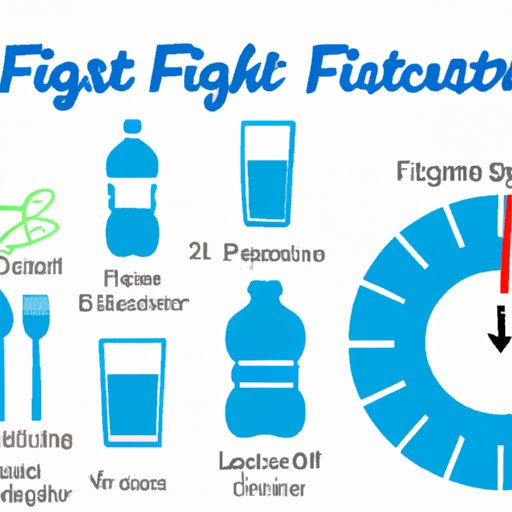Introduction
Intermittent fasting is an eating pattern that cycles between periods of fasting and eating. It has become increasingly popular as a weight loss strategy in recent years due to its potential health benefits. While there are several different types of intermittent fasting, the most popular is the 16/8 method, which involves fasting for 16 hours and eating within an 8-hour window each day.
Definition of Intermittent Fasting
Intermittent fasting is an umbrella term for various eating patterns that involve not eating for extended periods of time. This could be anything from 12 hours to multiple days, depending on the type of intermittent fasting you are doing. The most common type is the 16/8 method, which involves fasting for 16 hours and eating within an 8-hour window each day. For example, you could fast from 8 p.m. to noon the next day, and then eat all your meals between noon and 8 p.m.

Overview of Benefits for Weight Loss
The main reason why people use intermittent fasting for weight loss is because it helps to reduce calorie intake. By limiting the hours in which you can eat, you are effectively cutting out some of the calories you would normally consume in a day. Additionally, intermittent fasting has been shown to have other benefits for weight loss, such as improving insulin sensitivity, increasing fat burning, and reducing hunger levels.
Types of Intermittent Fasting
There are several different types of intermittent fasting that you can try if you are looking to lose weight. Here are some of the most popular methods:
Alternate Day Fasting
Alternate day fasting is a type of intermittent fasting where you eat normally one day and then fast the next. This means you would eat all your meals within a 24-hour period, and then fast for the next 24 hours. This type of fasting has been shown to be effective for weight loss, but it is also the most restrictive type of intermittent fasting and may not be suitable for everyone.
Time-Restricted Feeding
Time-restricted feeding is a type of intermittent fasting where you eat all your meals within a certain window of time each day. For example, you could eat all your meals between 8 a.m. and 8 p.m., and then fast for the remaining 16 hours of the day. This type of fasting is slightly less restrictive than alternate day fasting, and it has been shown to be effective for weight loss.
The 5:2 Diet
The 5:2 diet is a type of intermittent fasting where you eat normally five days a week and then fast two days a week. On the two fasting days, you would consume only 500-600 calories. This type of fasting is the least restrictive and has been shown to be effective for weight loss.
Science Behind Intermittent Fasting
Intermittent fasting works for weight loss by affecting several different metabolic pathways in the body. Here’s a look at how intermittent fasting affects metabolism, insulin, and glucose levels:
How Intermittent Fasting Affects Metabolism
Intermittent fasting has been shown to increase metabolic rate, which means your body will burn more calories even when you’re not actively exercising. This is because when you fast, your body enters a state of “metabolic switching” where it starts burning stored fat for energy instead of carbohydrates. This leads to increased fat burning and ultimately weight loss.
Role of Insulin and Glucose in Weight Loss
Intermittent fasting has also been shown to reduce insulin levels, which can help to regulate blood sugar and reduce cravings. Additionally, intermittent fasting can help to lower glucose levels, which can help to reduce hunger and prevent overeating. Both of these factors can contribute to weight loss.
Potential Risks and Side Effects
Although intermittent fasting is generally safe, there are some potential risks and side effects that you should be aware of. These include:
Possible Nutrient Deficiencies
If you are following a strict intermittent fasting regimen, you may not be getting all the essential vitamins and minerals your body needs. It is therefore important to make sure you are still getting enough nutrients by eating a balanced diet during your eating window.
Dehydration
Fasting can lead to dehydration, as your body is not getting the fluids it needs. It is therefore important to make sure you are drinking plenty of water throughout the day, especially if you are exercising.
Low Blood Sugar
When fasting, your body may not be getting enough glucose, which can lead to low blood sugar levels. If this happens, it is important to eat something to raise your blood sugar.
Success Stories
There are many success stories of people who have used intermittent fasting to lose weight. One such story is that of Megan, a 22-year-old woman who was able to lose 30 pounds in three months by following the 16/8 method of intermittent fasting. She found the diet to be manageable and sustainable, and she was able to keep the weight off for the long term.
Conclusion
Intermittent fasting is an effective way to lose weight, but it is important to understand the science behind it and the potential risks and side effects before starting. With the right mindset and dedication, intermittent fasting can be a great tool for weight loss.
(Note: Is this article not meeting your expectations? Do you have knowledge or insights to share? Unlock new opportunities and expand your reach by joining our authors team. Click Registration to join us and share your expertise with our readers.)
